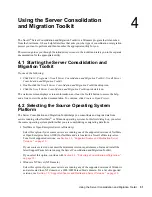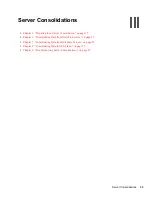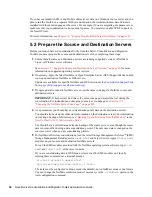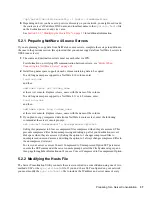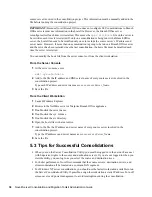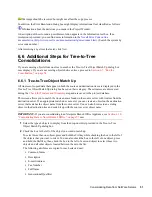
36
Novell Server Consolidation and Migration Toolkit Administration Guide
no
vd
ocx
(e
n)
6 Ap
ril 20
07
If you have extended ASCII or double-byte character set data on a Windows source server and you
plan to run the Toolkit on a separate Windows workstation, the workstation must have Windows
installed with the same language as the server. For example, if you are migrating a Japanese server,
make sure that your workstation is also running Japanese. You must also enable UTF-8 support in
the Novell Client.
For more information, see
Chapter 13, “Copying Double-Byte Character Set Data,” on page 121
.
5.2 Prepare the Source and Destination Servers
Before you launch Server Consolidation Utility from the Server Consolidation and Migration
Toolkit, you must prepare the source and destination servers by completing these steps.
1
Ensure that all source and destination servers are running supported versions of NetWare,
Linux, or Windows server software.
See
Section 1.3, “Supported Source and Destination Server Versions,” on page 18
for more
information on supported operating system versions.
2
If necessary, apply the latest NetWare or Open Enterprise Server (OES) Support Packs on both
source and destination NetWare or OES servers.
Updates are available for specific NetWare and OES versions at the
Consolidated Support Pack
home page (http://support.novell.com/tools/csp)
.
3
If copying data from and to NetWare servers, set the same code page for both the source and
destination servers.
IMPORTANT:
If both servers don’t have the same code page, data will be lost during the
consolidation. For instructions on changing your server’s codepage, see
Section 13.3,
“Changing the NetWare Server Code Page,” on page 122
.
4
As a precaution, you should have a current backup of all data on the destination servers.
You should also back up the eDirectory information on the destination servers. For information
on creating a backup of eDirectory, see “
Backing Up and Restoring Novell eDirectory
” in the
Novell eDirectory 8.8 Administration Guide
.
You should have a current data and trustee backup of the source servers, even though the source
data is not modified during a data consolidation project. The only time data is changed on the
source server is when you are consolidating printers.
5
For NetWare/eDirectory consolidations, load the latest Storage Management Services
TM
(SMS)
Storage Management Data Requestor (
smdr.nlm
) and Target Service Agent (
tsafs.nlm
)
modules on your source and destination NetWare servers.
To load the SMS modules provided with the NetWare operating system software, type
load
smdr
and
load tsafs
at the server console.
If you are consolidating data to OES Linux servers, load the SMS modules on Linux by
entering these commands at a terminal prompt:
/etc/init.d/novell-smdrd start
/opt/novell/sms/bin/smsconfig -l tsafs
The tsafs must be configured in Linux mode (the default), not in NetWare mode or dual mode.
You can change the NetWare emulation mode if necessary via the
--tsaMode
option in the
tsafs configuration command:
Summary of Contents for Server Consolidation and Migration Toolkit 1.2
Page 4: ...novdocx en 6 April 2007...










